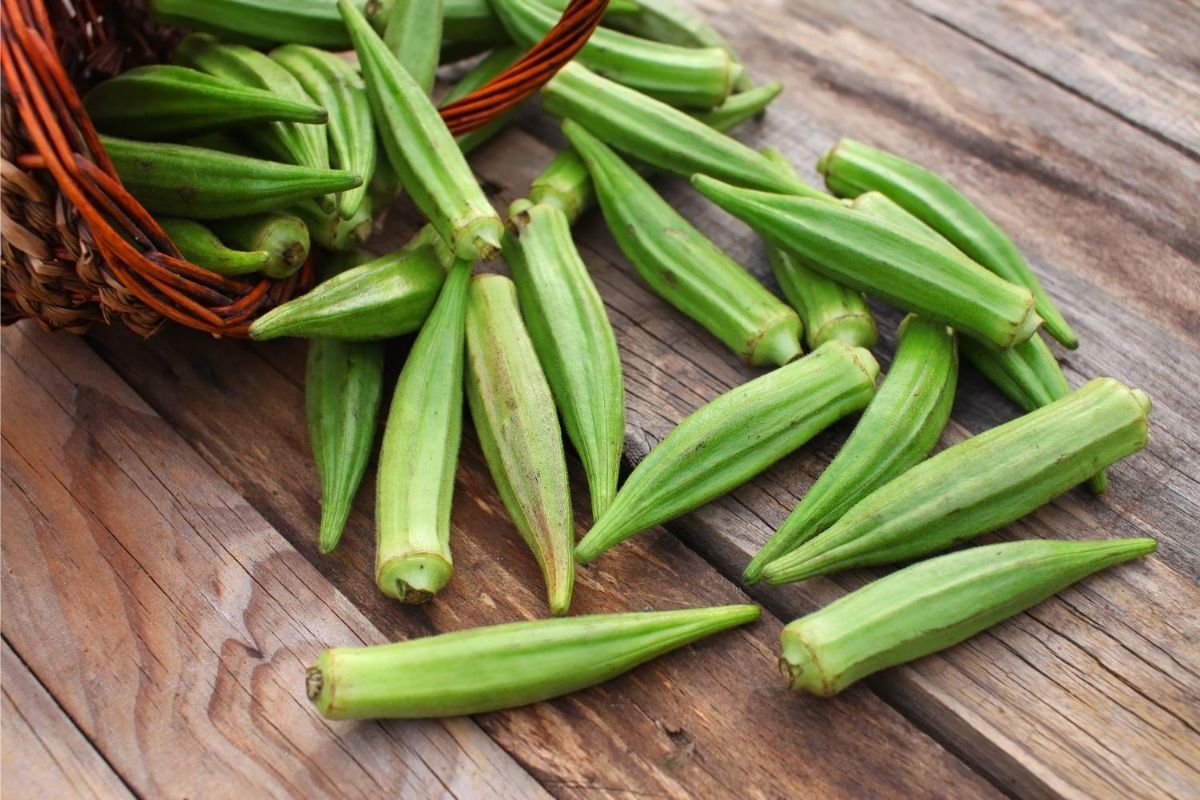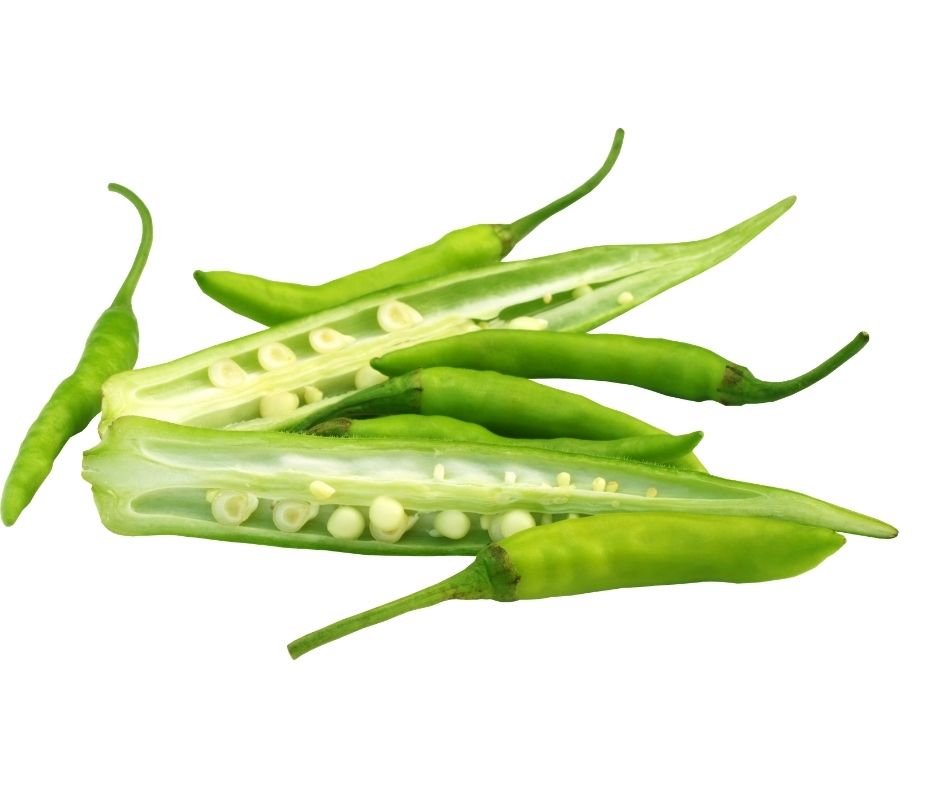Okra

Okra – properties, vitamins and nutritional values of okra
Okra is a typically African vegetable that has already gained popularity in the global gastronomic world. Okra, also known as “lady’s fingers”, actually belongs to the kitchen aristocracy. Its history probably began in Ethiopia, but as early as around the 12th century, okra was massively cultivated in ancient Egypt.
How does okra grow?
Okra is botanically a relative of hibiscus, tobacco and cocoa beans. The species, however, belongs to the mallow family and is typically tropical in nature. Tall stems covered with large palm leaves reach up to 2-3 meters in height and bloom with ornate, yellow, goblet-shaped flowers.
From the point of view of cultivation, the most important moment in the life of edible muskrat is the transformation of flowers into fruits, which must be harvested within 4-5 days – before they mature and grow to a length of more than 10 cm. Green pods, resembling a combination of zucchini and paprika, are the best when they are young and tender – later they lose their culinary attractiveness.
Inside each capsule husk there are white seeds arranged in a circular manner, which, after roasting, are used by African societies as a coffee substitute. The most important part of the plant, however, is the husk, which is eaten as a vegetable.

Okra – a healthy delicacy, not only for the hungry
The prevalence of okra in Africa is good news for the enormously large number of poor social groups who often suffer from malnutrition. Although the fruit of edible muskrat is not filling (the vegetable contains only 30 kcal per 100 g), it can boast an admirable vitamin and mineral composition.
From a dietary point of view, the particularly high level of vitamin K in okra husks is noteworthy. In addition, okra is rich in vitamins – vitamin A, B vitamins (including vitamin B9) and vitamin C. The mineral attractiveness of green scales is based mainly on the high level of magnesium and manganese, but also the content of phosphorus and potassium, sodium, calcium and iron.
Scientists also emphasize that tasty “lady’s fingers” are a mine of antioxidants – especially xanthine, lutein and beta-carotene. Finally, the high level of dietary fiber is also noteworthy, along with low levels of sugars and proteins, carotenoids, pectin, fats and carbohydrates.

What does this mean for the human body?
As a high-fiber food, okra supports a healthy metabolism – it stimulates the intestines, delays glucose absorption and lowers the risk of developing colorectal cancer. Vitamin A additionally stimulates the production of mucus, which protects and increases the functionality of the digestive system.
In addition, okra consumption has a beneficial effect on:
Blood sugar levels – Okra is used as a drug for diabetics in many African countries, and studies on rats show that indeed raw okra patches are effective in lowering glucose levels in diabetic rodents.
The skin – a combination of vitamins C and A is a natural regenerating and rejuvenating cocktail that stimulates the production of collagen. The influence of antioxidants on limiting the harmful activity of free radicals is also important.
Bone condition – a huge dose of vitamin K is of colossal importance for the structure of bone tissue, facilitating the absorption of calcium, and additionally supports the process of proper blood clotting.
Vision – The antioxidants contained in okra support the health of the retina and prevent the development of cataracts.
Pregnancy – B vitamins, and above all folic acid, present in high doses of okra shells are the best protection against neural tube defects in the fetus and support the healthy growth of the child.
In addition, there are studies linking okra with reducing blood cholesterol and triglycerides, lowering the risk of kidney disease, and supporting overall immunity.

Okra – culinary handbook
Fresh okra is a vegetable that can be easily bought today in markets in many parts of the world – especially those with a tropical climate. Experts recommend choosing firm, small scales that break easily in half. They can be stored for 2-3 days in the refrigerator and frozen without major damage to the structure.
For many people, the “slipperiness” of the coat is a deterrent. This is a completely natural and expected phenomenon – juice leaks from the husks, which is sticky and slimy, which is also used in many dishes, e.g. Creole cuisine, based on soups and sauces. You can reduce this stickiness by washing the scales just before use, and by avoiding minor cuts and long cooking, but it cannot be eliminated. Just as a fish has to be bristly, okra is slimy.
When it comes to taste, the lady’s fingers most often pick up the aromatic notes of the dish they are part of. It is a fairly neutral vegetable, and therefore universal, which is sometimes compared to eggplant. According to gourmets, okra tastes best fried – e.g. in batter – but in practice it is also used for stewed, boiled, grilled and steamed dishes. When added to soups or sauces, it wonderfully thickens its consistency, eliminating the need for a roux. Okra is added to dishes, but only about 10 minutes before the end of cooking.
Finally, there is also the possibility of using raw okra in vegetable salads, or even as a fresh snack – cut along the husk, just salt and pepper! In the cuisine of the southern United States, where the muskrat is known by the Creole name “gumbo” and is very popular, it is also used for pickling. Interestingly, even the leaves of okra can be eaten – they are used to prepare salads and stews like chard.

Famous dishes with okra
Edible musk husks have already entered the canon of many tropical cuisines. They are commonly used in vegetable mixes such as ratatouille – especially in combination with corn, tomatoes, onions and spinach.
In India, butternut squash is a valued ingredient in curry dishes, while in Africa it is used primarily for stews and nutritious soups, e.g. with beef, chicken or potatoes. From our point of view, okra is probably the most attractive in simple recipes, where you can appreciate its originality …

